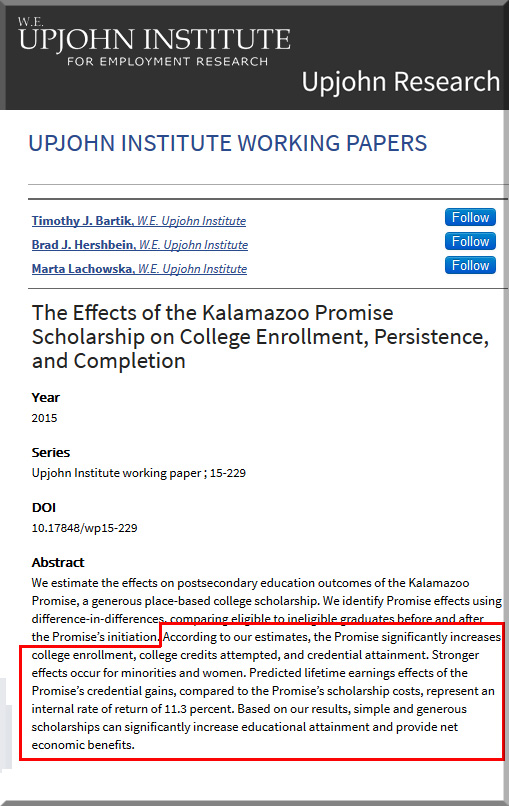Op-Ed: Free college? It doesn’t fix everything — from latimes.com by Richard Reeves
Excerpt:
Here is one solution to the rising cost of college: Make it free. That’s what a group of anonymous donors in Kalamazoo, Mich., accomplished a decade ago for local students. Almost every high school graduate in the town is eligible for a scholarship covering from two-thirds up to the entire cost of in-state college tuition.
President Obama is just one of many who praised the so-called Kalamazoo Promise, flying to the city five years ago to speak at the Kalamazoo High School graduation. More than 35 cities, from Denver and Pittsburgh to Ventura and Long Beach, have since adopted their own versions of the Promise. These schemes vary. Some have minimum GPA requirements, or target only low-income students. But they share the goal of bringing college within financial reach for all.
…
Can the Promise programs help create a more level playing field? The Kalamazoo program is now mature enough to provide some useful data. As always, there is good news and bad news.
First the good: High school graduation rates have shot up, and almost 90% of Kalamazoo high school seniors are enrolling in college, compared to around 70% for the state. Most encouraging of all, low-income and black high school graduates are almost as likely to enroll in college as their affluent and white peers. In fact, the black/white gap in college enrollment rates has completely disappeared in Kalamazoo, according to research from Timothy Ready at Western Michigan University.
Now for the bad news: Gaps by race and income reemerge when it comes to actually gaining a post-secondary qualification. The Promise has lifted college completion rates, but quite modestly, and far from equally.
From DSC:
The generous donors behind the Kalamazoo Promise are all anonymous — a far cry from having a football stadium or a new business school named after oneself for legacy’s sake. These folks didn’t want their names out there; they helped anonymously. Very cool!
Tim Bartik, Senior economist at the Upjohn Institute for Employment Research, had some good points regarding this article out on Twitter and on his Investing In Kids blog. So I’m adding some related items here:
Good policies will usually not “fix everything” — from investinginkids.net by Tim Bartik
Excerpts:
One surprising reaction to the Kalamazoo Promise has been to try to downplay the Promise’s success by emphasizing that many problems remain in Kalamazoo despite the Promise. While this is true, it is irrelevant to whether the Kalamazoo Promise is a good policy. Policies can have benefits far greater than costs without fixing all problems.
Here is what the evidence actually shows on the effects of the Promise, based on the recent report I wrote with my colleagues Brad Hershbein and Marta Lachowska. Our report evaluated the Promise by seeking to compare how the Promise had changed educational attainment for similar students over time.
- The Promise increases post-secondary credential attainment rates as of 6 years after high school graduation by one-third. The baseline rate was 36%, and the Promise’s effect was to increase the post-secondary credential attainment rate by 12%, an increase of one-third. Of this increase in post-secondary credential attainment, four-fifths was due to an increase in bachelor degrees.
… - What is true is that if one compares the present value of the expected future career earnings due to the Promise’s effects on credential attainment, with the present value of the costs of the Promise’s scholarship dollars, the ratio is over 4 to 1. I would call that a large benefit-cost ratio.
- Read more here >
Kalamazoo Promise boosts college completion by one-third — from investinginkids.net by Tim Bartik
Also see:
Kalamazoo Promise scholarship program ‘significantly’ increases college grad rates, study finds — from bridgemi.com by Julie Mack
Excerpt:
Six takeaways from the Kalamazoo Promise study:
- The Promise “significantly” increases college graduation rates.
- The increases are evident among low-income and minority students as well as more advantaged students.
- Promise-eligible students are 40 percent more likely to choose in-state public colleges compared with pre-Promise peers.
- Compared to pre-Promise peers, Promise-eligible students are a third more likely to attend a four-year college.
- The long-term payoff of The Promise is significant, and easily justifies the cost of the investment.
- The results are especially impressive because Promise scholarships are not awarded on the basis of financial need or merit.
Psalm 112:5 (NIV)
Good will come to those who are generous and lend freely,
who conduct their affairs with justice.









